The Collection Description Focus was created in June 2001 to try to improve co-ordination and consistency in activity in the area of collection-level description. The post is funded by three UK organisations/initiatives:
The CD Focus is based at UKOLN. As part of this activity, the CD Focus planned to undertake a survey of existing approaches to collection-level description in order to inform its work, and particularly to attempt to identify areas where problems were highlighted. Briefly, the aim of the survey was to obtain information on:
Although the CD Focus is concerned primarily with collection-level description activity within the UK, and its direction is shaped by the (primarily UK-oriented) concerns of the three funding bodies, it is also informed by work outside the UK and by work undertaken by constituencies beyond those with which the funding partners are primarily concerned.
This broader concern is reflected in the close relationship between the CD Focus and other activity within UKOLN, particularly the explicitly cross-domain interests of the Interoperability Focus, but also other resource description/metadata activity, such as the work done in support of the Dublin Core Metadata Initiative.
CIMI is an international consortium of cultural heritage organisations and institutions. CIMI encourages an open, standards-based approach to the creation and sharing of information in the sector and is particularly active in evaluating the application of standards within the sector through demonstration projects.
At the CIMI Members meeting in New York in June 2001, the area of collection-level description was discussed briefly, and it was suggested that it would be mutually beneficial for the Focus and any CIMI working group operating in this area to share information wherever possible. CIMI expressed an interest in surveying current collection-level description activity within the museum domain.
It was subsequently agreed that CIMI and the Focus might collaborate on the construction of the questionnaire planned for the CD Focus so that it might be possible to address the same questions both to the (cross-domain) UK constituency that the Focus wished to survey and to the international museum constituency that CIMI wished to cover. This was realised through a small working group co-ordinated by Pete Johnston (CD Focus, UKOLN) and Neil Thomson (Natural History Museum, London).
The questionnaire was made available at the end of September 2001 and was publicised on various mailing lists (see Appendix A), on the CD Focus and CIMI web sites, and by CD Focus at meetings during October 2001. The questionnaire was available for a period of approximately one month. It was open to anyone with an interest in the area of collection description, though the majority of the questions were directed to institutions and projects actively involved in the creation of descriptions at collection level.
Since the questionnaire was made widely available, the responses received reflect a wide range of experiences, contexts, and approaches. Most (but not all) responses are from institutions or projects currently involved in the creation of collection level descriptions. Many of the responses were completed by the staff responsible for collection-level description activity and provided valuable details of implementation experience.
The survey received 106 completed responses, plus two expressions of interest from respondents who were unable to complete the form. The following represents a preliminary overview of these responses. The “open” nature of several of the questions allowed respondents to provide a considerable amount of detail in their answers. This overview does not necessarily reflect the full richness of those more detailed responses, but that information may be used in further analyses of the survey information.

The majority of respondents (62%) were UK-based, which is probably a reflection of the membership of the distribution lists which were targeted.

The questionnaire made a high-level distinction between the description of activity across an organisation and activity within specific projects.
There was little difference between the number of respondents who described collection description activity as pertaining to a particular project and those who described activity across the institution. Responses suggest that in practice that distinction is not easy to make in all cases. Some responses reflected the contributions of a single institution to multiple activities/projects; in a small number of cases, institutions submitted multiple responses each reflecting a single activity/project. It was noted that there were several independent responses from contributors to a single multi-contributor activity/project (for example, the UK Archives Hub, which is building a “union catalogue” of ISAD(G)-conformant fonds-level descriptions of the archival holdings of UK HE and FE institutions). Some responses were from projects still in the process of planning and designing their approaches to collection description and in those cases their answers to some questions reflected their position as far as it had been decided at that time.

N.B. Total of percentages in appendix exceeds 100% because several respondents identified themselves as working in multiple domains.
Perhaps not surprisingly, a large number of responses came from institutions and projects within the archival domain, where there is an established practice of description at the aggregate level. In some of the tables below, we attempt to present:
N.B. Total of percentages in appendix exceeds 100% because several respondents identified their collections as covering multiple subjects. Several respondents did not specify subject coverage.

Almost all the respondents (96%) were already actively involved in creating collection-level descriptions (or were planning to do so in the immediate future).

While staff and financial resource considerations are significant, a large majority of respondents identified collection-level description a forming part of their strategy to disclose information about their resources.
Where "other" factors were noted, these included:
See also responses to Q17 at section 4.5.

As in the case of the question on "Domain" (Q11), there is an emphasis on the description of archival collections and special/manuscript collections, areas where the practice of collection-level description has traditionally been better established.
Where "other" types of collections were identified these included:

Again, the emphasis on defining collections by provenance perhaps highlights the large number of respondents describing archival holdings.
Other criteria cited included:

Collection descriptions are created primarily for purposes of resource disclosure/discovery (93%) and resource management (48%).
Other purposes cited:
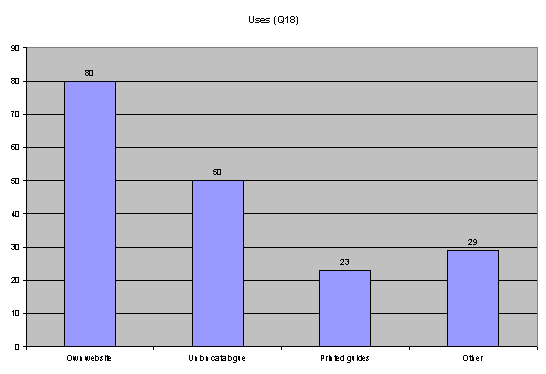
While the emphasis remained on use of collection descriptions within a project or organisation's own Web site (75%), a substantial minority (47%) were engaged in some form of sharing of collection descriptions in a "union catalogue" context.
Other uses cited included:

A relatively large number of respondents (58%) reported that they were not required to adopt a specific standard for collection description. This is probably an indication of the absence of any widely adopted standard in this area, outside the archival community.
5.2.1 Based on full response set

A significant number of those who checked "Other" specified that they were using MARC/AACR2 for collection-level records, and it was an oversight not to have included this as an option in the questionnaire. (The additional bar to the right of the "Other" column highlights this subset. N.B. The 18 MARC users are still included in the count of 42 "Other" schema users). Most of the other responses under "Other" referred to project-specific schema or extensions to one of the other schemas listed.
The emphasis on the use of ISAD(G) and/or EAD again reflects the significant proportion of respondents describing archival collections. The graph below represents an attempt to illustrate the response from that group who identified themselves as working outside the archival domain.
5.2.2 Based on subset excluding archival domain
i.e. 77 respondents who checked a domain other than Archive in Q11 (but may have included Archive with other domains)

5.2.3 Based on subset including museum domain
i.e. 22 respondents who checked a domain Museum in Q11 (and may have included other domains)
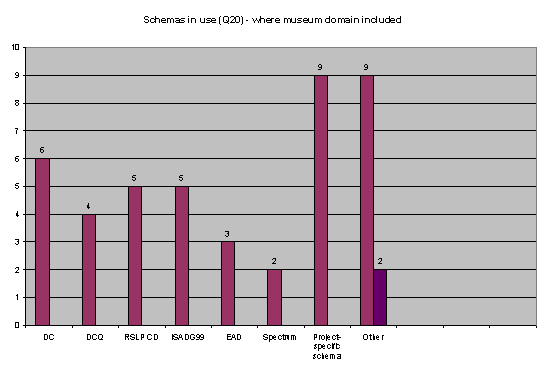
5.2.4 Difficulties using schema (Q21/Q21.1)
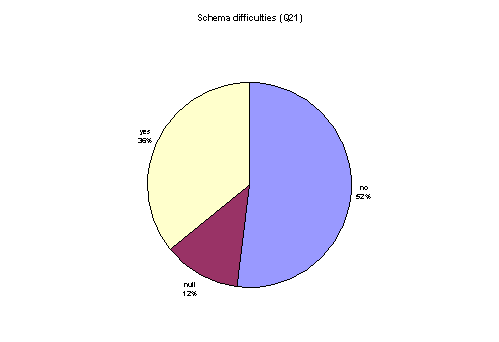
A large minority (36%) reported difficulties in applying their selected schema for collection-level description, which is perhaps another indicator of the emerging nature of best practice in this field.
Problems reported included:
5.2.5 Mapping/converting between schemas (Q22/Q22.1)
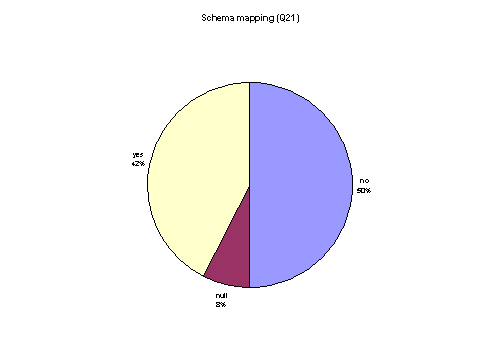
Mapping requirements mentioned included
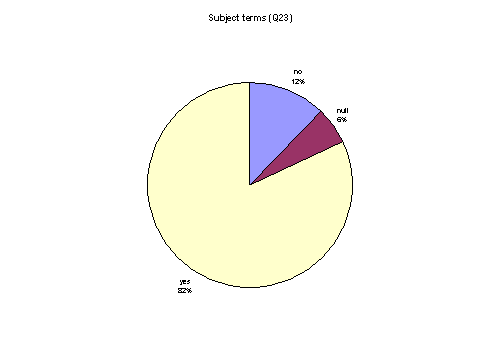
A large majority of respondents made use of subject terms within collection-level descriptions.
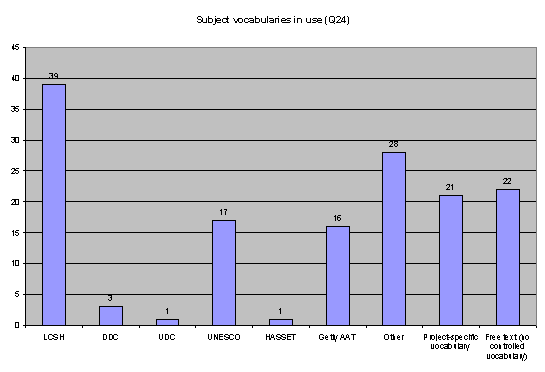
Other vocabularies mentioned included:
5.3.1 Subject Difficulties (Q25/Q25.1)
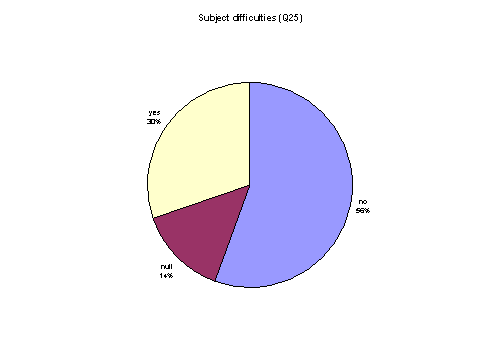
Although subject is a significant access point for collection-level description, the selection of a suitable thesaurus/vocabulary is also a problem area. Almost all of the difficulties identified related to the fact that general-purpose subject vocabularies like LCSH and UNESCO were not specific enough for use in specialised subject areas. Other comments included:
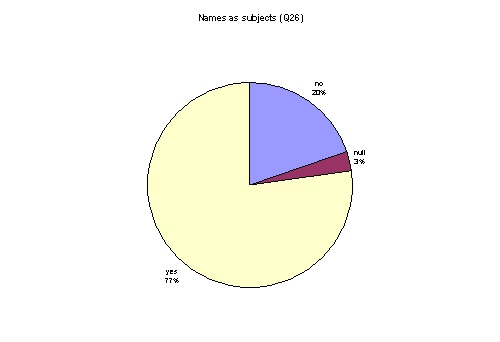
Name rules in use (Q27)
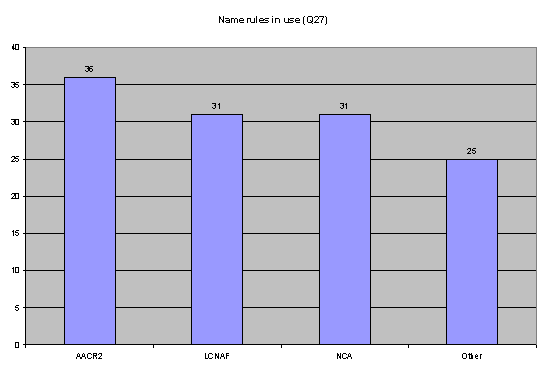
5.4.1 Name Difficulties (Q28/Q28.1)
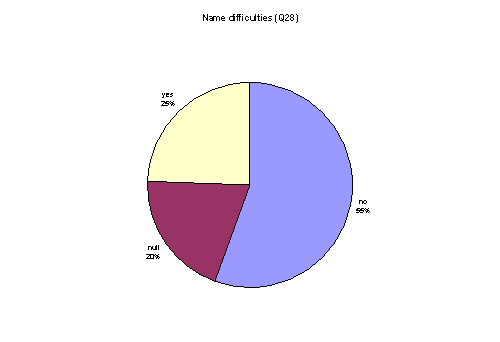
Difficulties specified included
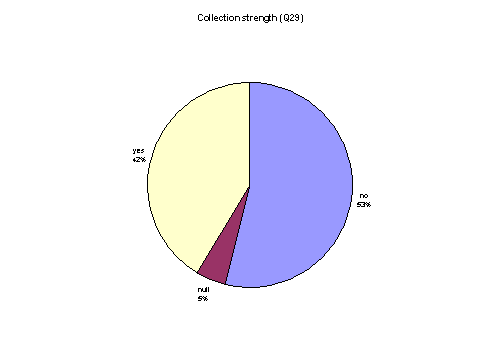
5.5.1 Standards for strength (Q30)
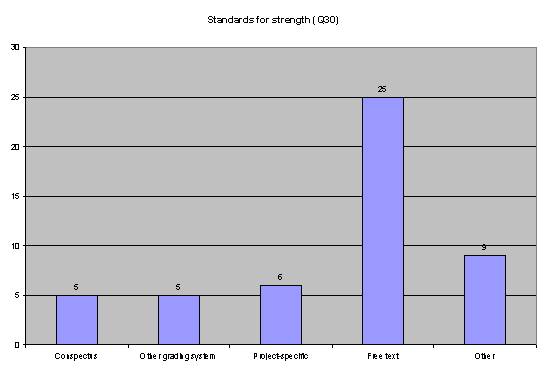
Responses showed little use of Conspectus or other grading systems for collection strength. Some respondents employed some measure of the size of the collection as a measure of its strength.
Several respondents from the archival domain referred to the use of ISAD(G)'s "Scope and content" element as adequately covering the strength of an archival collection.
5.5.2 Comments on strength (Q31)
Several respondents commented that had not encountered the idea of "collection strength". Some commented on the "subjective" nature of an assessment of strength or the resources required to apply a system like Conspectus effectively.
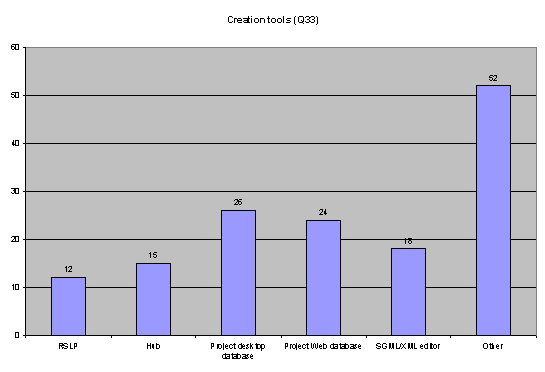
Perhaps not surprisingly, questions on implementation revealed the widest range of responses, with almost half of the respondents selecting the "other" option. Where other methods were specified, these often included responses which fell within one of the earlier categories, but important additions included:
Again, responses here varied widely to the extent that a summary has not yet been prepared.
The fields cited as access points varied enormously, depending on the nature of the collections, but typically included:
Note: some responses to this question may in fact have referred to queries on records describing items within the collection, rather than on the collection-level descriptions themselves.
Comments included:
Comments included:
Comments included:
Several respondents noted that their responses were made based on work at the early stage of activity
Other comments included:
More than anything else, the survey highlighted that there are a wide range of approaches to collection-level description. But given that description at collection-level is applied in many different contexts and to many different classes of resource, this diversity is only to be expected.
There are exceptions to this picture of variation. The most significant is, of course, within the archival community where there are established standards for "multi-level" description which are now widely implemented. There was also significant evidence of the use of MARC for collection-level description, particularly in the US. And in the UK, a number of implementers are making use of the RSLP CD schema, particularly within the scope of the RSLP programme itself.
There was evident interest in, and recognition of the value of, description at collection-level, particularly for purposes of resource disclosure/discovery.
The comments on the use of subject vocabularies perhaps reflect the fact that implementers see collection-level description playing a role both within specific domains or subject areas and in cross-domain activity. In fact this perhaps introduces contradictory demands: for specificity and fine-grained description on the one-hand and for commonality and generality on the other.
There is a clear interest in the development of standardised approaches, particularly to facilitate resource disclosure/discovery across domains, but some comments also suggested the need for more support for domain-specific approaches to collection-level description.
Implementers require more information on the concepts and terminology of collection-level description and on approaches to, and standards and specifications for, collection-level description. Standards should be supported by flexible, easy to use tools for the creation of descriptions.
In terms of highlighting priorities for the work of the CD Focus, the survey perhaps offers fewer clear pointers than had been hoped. However, it does highlight the requirements for guidance and support and more channels for the sharing of information in this area, which the Focus hopes to address with its programme of workshops. Some UK respondents highlighted the unsatisfactory nature of the present situation where resource holders may find themselves asked to re-describe collections according to the diverse requirements of several different collection description activities.
CIMI plans to continue discussing the role and purpose of collection-level description within the museum community.
It was very encouraging to see that a number of respondents provided detailed information on their activities and to recognise that there is development activity in this area and an interest in sharing information on that activity. There were a number of detailed replies from the US and Australia which highlight the international interest in collection-level description, which might usefully be pursued within the Dublin Core Collection Description Working Group.
Notice of the survey questionnaire was posted to several mailing lists, including the following:
collection-description@jiscmail.ac.ukcimi-membership@cimilists.rlg.orgcimi-friends@cimilists.rlg.orgrslp-announce@jiscmail.ac.ukrslp-cd@jiscmail.ac.ukdner@jiscmail.ac.ukcni-announce@cni.orgdc-general@jiscmail.ac.uke-collections@jiscmail.ac.ukarchives-nra@jiscmail.ac.ukartnet-all@jiscmail.ac.uklis-link@jiscmail.ac.ukmcg@jiscmail.ac.ukinteroperability@jiscmail.ac.ukead@listserv.loc.gov